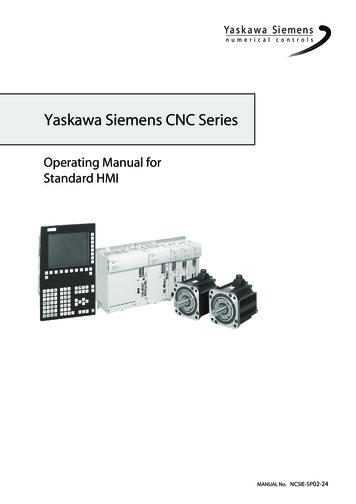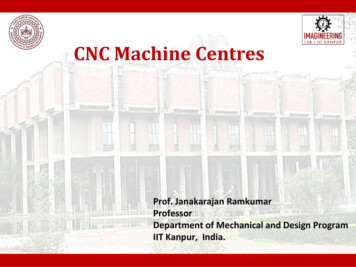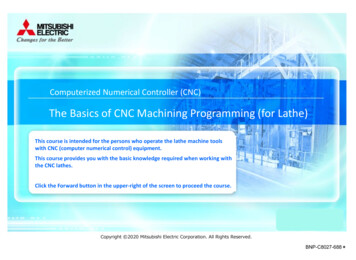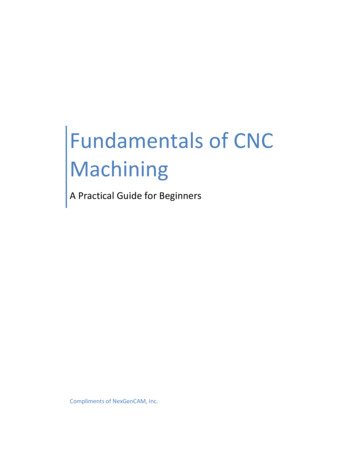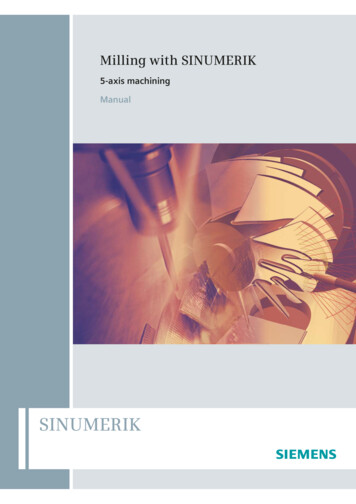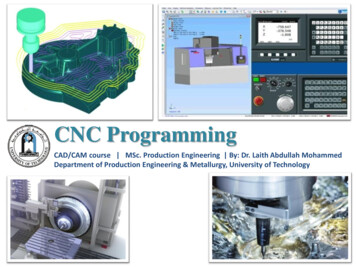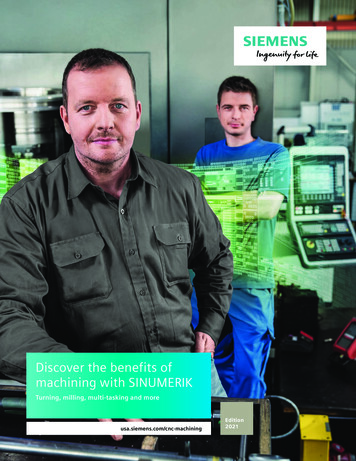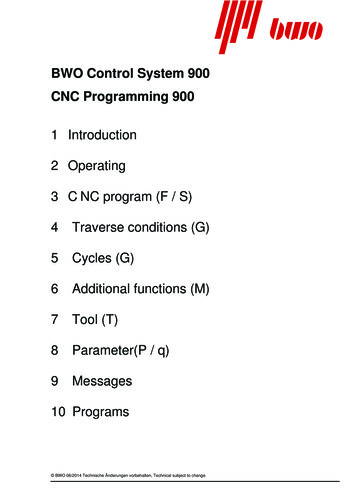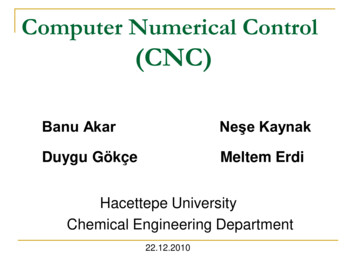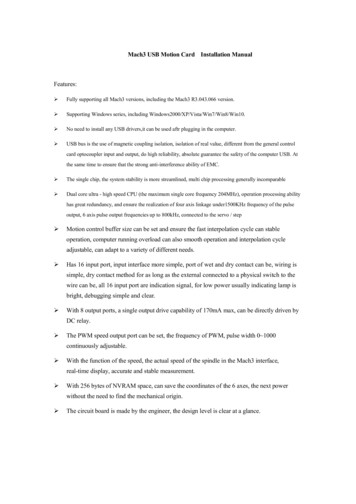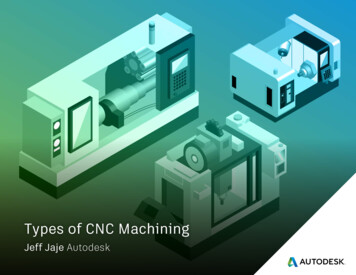
Transcription
Types of CNC MachiningJeff Jaje Autodesk
INTRODUCTIONWhat is a CNC machine?Originally milling machines were manual in operation. Movementof the part or tool was often accomplished by manually turninghandles that turned the ball screws or manipulated various leversof the machine. Basic automation allowing the machine to move inone direction, once the part location was set by the machinist.CNC is an acronym for Computer Numerical Control, where acomputer is connected to the mill, along with electricaldrives and sensors for a complete system. This computercontrols the movement of the machine axis.CNC machines are very precise, with precision and repeatabilitythat can exceed what is possible through manual movements.CNC mills can vary in size from just a few inches of travel, to havinghundreds and sometimes even thousands of inches of travel.The idea for CNC machines is often credited with John T. Parsons,who was a machinist and salesman at his father’s machiningcompany. He wanted a way to make aerospace parts that werelower in cost and more consistent than traditional methods. Aftervarious false starts, collaboration between Parson’s, the UnitedStated Air Force and MIT led to the development of the firstNC machines which were run from a punch tape.Types of CNC Machining 2
Traditional Milling MachineTypes of CNC Machining 3
TABLE OF CONTENTS01: INTRODUCTIONPages 1 - 402: COMPONENTS OF A CNC MACHINEPages 5 - 703: PROGRAMMING A CNC MACHINEPages 8 - 904: TYPES OF CNC MACHINEPages 10 - 1305: NON MILLING MACHINESPages 14 - 1506: CONCLUSIONPage 17Types of CNC Machining 4
COMPONENTS OFA CNC MACHINETypes of CNC Machining 5
COMPONENTS OF A CNC MACHINEMost milling machines have some similarcomponents. First you have the machine base.This usually includes the work table and gearing,typically ball screws, for machine movement. Thiscan also include the electric drives that move thevarious components of the machine.CNC machines also require what is usually calledthe “controller”, or the computer part of CNC. Thiscomputerized controller utilizes the programmedinput values, and data from the feedback loops,to control the movements of the oolAdditionally, milling machines include a spindleof some sort. The spindle either spins the cuttingtools for milling, or in the case of a lathe, it spinsthe actual part for the lathe tooling.Lastly, to successfully CNC mill parts, you will needcutting tools compatible with your mill and materialbeing cut.TableTypes of CNC Machining 6
PROGRAMMING ACNC MACHINETypes of CNC Machining 7
PROGRAMMING A CNC MACHINELocation data for CNC milling can be entered intothe controller manually, usually via the keyboardand built in screen, often this is done from ablueprint or drawing. Alternatively, a CAD/CAMsystem can be used to design and program thepart, with the resultant program being loaded orfed into the CNC controller.The code used to run the mill is often referred toas Geometry code, or more commonly, “G-Code”.Controllers also have “M-codes” or miscellaneouscodes, such as a code to turn on or off the spindle,or coolant. This code was developed in the 1960’swhen computers had small amounts of memory,and a short hand notation of commands for CNCcontrollers was needed, to fit larger programs.Programming with CAD/CAM systemOn-machine programmingTypes of CNC Machining 8
TYPES OF CNC MACHINETypes of CNC Machining 9
TYPES OF CNC MACHINESCNC machines will have movement that is eitherlinear, or straight line, in motion or rotational.Typically the X, Y and Z axis are used for linearmovements, whereas A, B or C will correspondto rotational axis, with A rotating about the Xaxis, B about the Y axis, and C about the Z axis.zCNC machine designs will vary greatly. On somestyles, the part will move or rotate while thespindle and tool remains stationary, in othersthe part is stationary and the spindle and toolmoves, and a third type is a mixture of eitherthe part and spindle moving.A list of the common CNC machining operationsand the types of CNC machines they run onis outlined on the next page. There are manycustom built CNC’s which fit outside of thesecommon types.bacxyCNC machine movementTypes of CNC Machining 10
TYPES OF CNC MACHINES3-AXIS MACHININGThese are the most common CNC machines produced commercially. They can move in the X, Y and Z axes simultaneously. The mostcommon size of the 3 axis machine is one with a work table of 40x20 inches. Work performed on 3-axis machine can be simple prismaticparts, all the way to complex molds, medical or aerospace parts.3 1 OR 3 2 AXIS MACHININGThis type of machining, and CNC machine, combines rotational movements with linear movements. In this type of machining, the part willfirst rotate into position, and then a typical 3-axis machining operation will commence after rotation. The rotation and linear movementdoes not happen simultaneously.If the machine supports rotation around just one axis, then it is considered 3 1 machining, for 3 linear axis and one rotational axis. If themachine can rotate about two axes, it is referred to as a 3 2 axis machining.CNC machines can be purpose built as a 3 1 or 3 2 axis mill, but more commonly, they are created by adding a rotating component to anexisting 3-axis mill. The latter method will reduce the work envelop size, so that should be taken into consideration when outfitting a mill.One major advantage to 3 1 and 3 2 machining is in reducing individual setups when milling a part. Some parts may require milling ondifferent sides, and on a 3-axis machine, the machinist would remove and reposition the part between operations. This can sometimestake a long time, where it could rotate into position automatically with 3 1 or 3 2 functionality.Note that setting up and programming 3 1 and 3 2 axis machines manually, versus programming with a Computer Aided Manufacturing(CAM) system is often difficult, time consuming and prone to errors.4-AXIS SIMULTANEOUSThe difference in 3 1 and 4-axis simultaneous is that the part can rotate on one axis at the same time it is milling in 3-axis.This type of machining is necessary when part geometry wraps around a part, common in the aerospace and other industries.While all 4-axis simultaneous milling machines can perform 3 1 axis milling, not all 3 1 axis mills can do 4-axis simultaneous.One needs to make sure of their machine’s capabilities before trying to run a program it may not support.Types of CNC Machining 11
TYPES OF CNC MACHINES5-AXIS MACHININGThis type of machining allows for the most flexibility in milling the part at different tool orientations. Here, the part can rotatein two separate axes, usually A&C or B&C, at the same time the 3 linear axes are moving.Machining in simultaneous 5-axis is popular in parts where complex shapes, and small clearances, are the norm; such asimpellers, turbines, intake ports and more.True simultaneous 5-axis machines can run in all the previous modes; 3-axis, 3 1 axis, 3 2 axis, 4-axis simultaneous plus5-axis simultaneous. While all 5-axis simultaneous machines can perform 3 2 axis machining, not all 3 2 axis machines can do5-axis simultaneous. It is a function of the machine’s design and the CNC controller installed.These mills are typically more expensive than the other mill types, for the same size, but offer the most flexibility when settingup your jobs.LATHEOften referred to as turning, and usually used for round parts, a lathe is slightly different than a milling machine. With a lathe,instead of the part being stationary and the tool spinning, the part is put into a “chuck” and spun. From there, a cutting tool isused to carve out the shape needed.Some common options on lathes are automatic bar feeder, to feed material through the spindle to the chuck. Other commonoptions are tail stocks to support the spinning part in the front and back.MILL TURNThis is a special type of lathe. Sometimes referred also as live tooling, it is a lathe where a small spindle with a rotating cuttingtool can be added. These types of mills and operations allow users to create round parts that have milled or drilled features onthem, without having to mount them into a different mill.Types of CNC Machining 12
NON MILLING MACHINESTypes of CNC Machining 13
NON MILLING MACHINESMills and lathes both use a spindle to either spin a tool or the part. However, there are other CNC machines usedin manufacturing that do not have spindles.WIRE EDMThese types of machines use a special wire, fed from a spool, with an electric current passing through it, to remove material.The wire essentially slices through the metal. These machines are often used on tool steels and stamping die components.Wire EDM machines can be 2 axis or 5 axis. With a 2-axis, the wire cuts a profile. In 5-axis, the wire holders at the top and bottomcan move independent of each other to create ruled surface shapes.WATERJET CUTTERHigh pressure water, often with an added abrasive, is used to cut through a variety of materials. Water jet cutters can cut throughplastics, metals and even stone and granite.Most water jet CNC machines are 2 axis, and only cut a profile, however, there are 5-axis water jet machines available as well.LASER CUTTERLike a water jet, most laser cutters are 2-axis and used to cut profiles through sheet stock. However, instead of using a pressurizedwater stream, they use a laser sufficient for the material. Depending on the laser and design, laser cutters can cut through acrylic,polymers, and various metals.For contoured sheet metal stampings, it’s common that they are trimmed with a 5-axis version of a laser cutter.PLASMA CUTTERSimilar to lasers and water jets, a plasma cutter usually cuts through sheets and plates. Plasma cutters work on electricallyconductive materials, and cut by means of an accelerated jet of hot plasma.Besides cutting metal sheets, plasma cutting is capable of cutting thick plates, often used in boat building. Most plasmacutters are 2 axis, but 5-axis versions are available.Types of CNC Machining 14
CONCLUSIONTypes of CNC Machining 15
WHAT TYPE OF MACHINE IS RIGHT FOR ME?There are many factors that go into picking a CNC machine. The types of parts you plan to millwill dictate what type of mill you will need. Most prismatic parts, or individual componentsfor mold and die can be done with 3-axis operations. Many medical or power generationcomponents require 3 2 or 5-axis machining. Mill Turn is common in a lot of aerospaceapplications.REVIEWA CNC milling machine consists of the machine base and moving axes, a computerized controller,and some form of spindle to rotate the cutter or part.These machines are run from data either programmed in by hand, or created by a CAD/CAMsystem. There is a lot of variety in the types of machining, and types of machines. One shouldpick a technology suited to the type of part they plan to create. Check our other articles for moredetailed descriptions of CNC milling technology.To explore more information about CAM programming andCNC machining, visit our manufacturing resource center.RESOURCE CENTER Types of CNC Machining 16
Autodesk, the Autodesk logo are registered trademarks or trademarks of Autodesk, Inc., and/or its subsidiaries and/or affiliates in the USA and/or other countries. All other brand names, product names,or trademarks belong to their respective holders. Autodesk reserves the right to alter product offerings and specifications at any time without notice, and is not responsible for typographical or graphicalerrors that may appear in this document. 2017 Autodesk, Inc. All rights reserved.
CNC is an acronym for Computer Numerical Control, where a computer is connected to the mill, along with electrical drives and sensors for a complete system. This computer controls the movement of the machine axis. CNC machines are very precise, with precision and repeatability that can exceed wh
